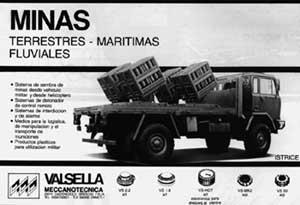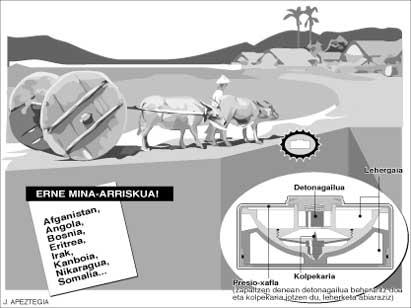Underground risk
Today, pain and submunition are used by armies around the world in their daily activity, both in defense and in attack. The production of weapons of mass destruction is a field that has been gaining strength year after year, and in recent times its hegemony has been revealed. Therefore, companies working in the arms sector have given priority to this, and if we say that an easy and round business has happened to them, we are not very wrong. While the anger of public opinion has been directed against nuclear weapons, they have simultaneously created a field as dangerous as this one.

According to the dictionary, pain is an underground or underwater device that can cause the explosion remotely or explodes when someone or something is crushing. If we analyze militarily, on the other hand, the sense of pain appears to us much wider; according to the General Defense Board of the US, any war conflict and all kinds of ammunition that remains unresolved once the war is over must be considered as pain. Therefore, submunition of the same characteristics as mines is considered a weapon of mass destruction.
The origin of the term pain comes from a tactic known from time immemorial. To reach the walls of the enemy, the soldiers moved away from the underground galleries. Since gunpowder began to be used, at the end of these galleries an explosive was placed that allowed to approach the walls and even attack.
In World War I, the German army used for the first time the weapon that can be considered the precursor of current pain. In essence, they looked at the characteristics of the grenades they used by hand, and from there came a more powerful weapon than this. Pomegranate's spawn was placed up and placed on the ground. The goal was to explode by passing over and smashing the tanks and, of course, they were right.
The pains used in World War II had an iron body, like the original pomegranate. From 1942, on the other hand, they are mainly made of glass, bakelite or wood to avoid electromagnetic detectors. The mine bursting system, submerged or buried, is similar in all cases. The explosion pain occurs by a small touch, but there are also mechanisms that explode at a distance. The latter are mainly used to blow up sea mines.
Although the original objective of the mines was to attack the tanks, since World War II anti-soldiers began to proliferate. Both targets are currently mixed, so mining zones are mixed in almost all cases.
Among the submunitions are the dispersion pumps. They explode in the air and disperse dozens of bombs in the vicinity; those that burst or last as pain.
Real risk in sight

The importance of pain and submunitions lies in their ability to cause massive destruction. And is that thrown from the air or buried provoke more dead and wounded than war conflicts. On the other hand, sustainability brings its strategic value to weapons: if it is planted in a territory, the average duration of a mine is 40 years. Hence, precisely, one of the ironies of the war: once the conflict is over, the inhabitants continue in a situation of war without being able to regain normality.
In addition, the pain and use of submunitions are very cheap. You can get a mine for $3, while its attenuation costs almost $1,000.
Civilians are the main victims of mines. Greenpeace claims that 800 people die every month of narcotics exploded by the mines they left in the fields and roads after any war. Today there are more than 200 million mines spread around the world awaiting an explosion. In Cambodia, for example, mines have killed more civilians in three years of peace than in twenty years of war.
Looking ahead, the economic consequences are the most serious: the prosperity of the lands, the deterioration of the infrastructures, the dependence of the external assistance... and a long etcetera. For example, in Afghanistan he was able to produce all the food he needed before the war. It currently depends on the import of food.
In Cambodia, Nicaragua, Vietnam or Angola, they may forget that the war ended a long time ago, but they will have long consequences.
“FOB Pain Karachi intends to cause personal harm. Research confirms that hurting the enemy is more effective than dying. Wounded soldiers need a lot of attention and this makes transportation and health services difficult. In addition, the wounded cause more psychological pain to the Army.” CompanyArmera of Pakistan.
“The pain causes problems to return refugees. They condition economic development, create permanent chaos and make it impossible to regain the political balance”
U.S. State Commission. Report “Dead Killers.”
Arms of the arms industry in Euskal Herria Today, the pain and production of submunitions worldwide is in the hands of more than 50 companies or groups, including Alliant Techsystems, USA, Valsella Meccanotecnika (FIAT dependent), Italy, or Chilean Cardos. In the Basque Country, the company EXPAL (Explosivos Alaveses S.A.) has under its control the pain and most of the production of submunitions throughout the Spanish State. It depends on the group ERCROS and therefore closely linked to the KIO cuwaitarra. He was born in Vitoria-Gasteiz in 1946 and his best time dates back to the 1960s. However, the current ones are not excessively bad, with an annual turnover of 10 12 billion pesetas. You cannot know exactly what is the route of pain in Vitoria, since economic operations are carried out through subcontracts. The only thing we have been able to know in detail is that the Spanish State Army is the most “honest” client of EXPAL. |






